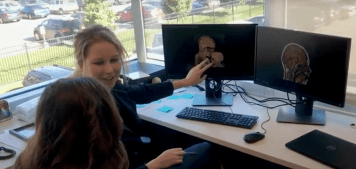Main Discipline(s):
Main Professional Societies:
Affiliation(s):
- Neuroscience
- Society of Biological Psychiatry
- International Cannabinoid Research Society
- Wayne State University Department of Communication
1. The impact of childhood trauma —including interpersonal forms of trauma (e.g., violence) and medical-related trauma (e.g., cancer diagnosis, treatments) — on brain and behavioral development in children and adolescents
2. The role of the endocannabinoid system in modulating frontolimbic brain development and risk of fear-based disorders.
3. Behavioral (e.g., exercise, meditation) or pharmacological interventions (e.g., cannabidiol, CBD) that target the endocannabinoid system for the treatment and/or prevention of fear-based disorders in youth
4. The impact of prenatal cannabis exposure and adolescent cannabis use on neurodevelopmental and mental health outcomes.
My graduate research used structural and functional neuroimaging approaches to study the impact of stress and childhood trauma on brain and behavioral development in children and adolescents. We found that changes in the brain often precede the emergence of psychiatric disorders, like anxiety and depression, and that early trauma may increase vulnerability to these disorders in some youth. Then, as a postdoc in Dr. Christine Rabinak’s lab in the WSU Dept. of Pharmacy Practice, we developed a novel paradigm to study fear dysregulation as a core mechanism underlying the link between early trauma and the development of fear-based disorders, like anxiety and PTSD. Dr. Rabinak does really exciting work on new treatments for anxiety and PTSD in adults that target the endocannabinoid system, which is a primary regulator of stress and anxiety in the brain and body. In her lab, I became really interested in the role of the endocannabinoid system in modulating brain development, and risk of anxiety disorders during childhood and adolescence. My current research looks at natural variation in the endocannabinoid system in risk of anxiety in children and adolescents, and also interventions that may work on the endocannabinoid system — such as exercise or cannabidiol (CBD) — as potential preventive interventions or treatments for anxiety or PTSD in youth. We also look at the impact of cannabis and cannabinoids on vulnerable populations, such as how cannabis exposure during pregnancy can affect neurodevelopment in children, and effects of adolescent cannabis use on the brain and mental health outcomes.
I am most excited about two things: (1) the promise of the endocannabinoid system for understanding and treating child and adolescent anxiety, and (2) about widening our lens of what we consider environmental stress – to include both chemical (e.g., air pollution, lead exposure) and non-chemical (e.g., , trauma) stressors. Our research centers on Detroit, Michigan, a largely minority, under-resourced city that is disproportionately affected by environmental injustice, such as violence and air pollution. A brilliant new postdoc in my lab, Dr. Clara Zundel, is tackling neurodevelopmental mechanisms underlying the emerging link between air pollution and anxiety symptoms in children and adolescents. My amazing research coordinator, Breanna Borg, MPH, is tackling the physical and psychological consequences of community violence in youth, particularly gun-violence.
Improving our knowledge of the endocannabinoid system and how it affects child and adolescent neurodevelopment can directly inform new interventions to prevent anxiety in at-risk youth, such as children exposed to trauma. This is a badly needed area given that anxiety disorders are the most common childhood disorders, affecting nearly 1 in 3. We are beginning to explore interventions – like exercise and cannabidiol (CBD) – for reducing anxiety symptoms in children and adolescents.
I have always loved the books by the late Oliver Sacks, such as “The Man who Mistook his Wife for a Hat”. He was a neurologist who — on top of being an excellent scientist and clinician — had a poetic way of chronically the experiences of patients with brain disorders. These books got me really excited about the brain initially.
There are also a lot of really great podcasts about the brain and brain disorders – like the Huberman Lab podcast (by Stanford neuroscientist Dr. Andrew Huberman) and the JAMA podcast. I really love science communication and actually started my own podcast — brainSTEM — earlier this year with two excellent trainees, Amanpreet and Manmeet Bhogal (siblings), who have expertise in videography and podcasting. Our podcast is about the brain and brain disorders, and each episode focuses, for the most part on a brain disorder such as schizophrenia, Tourette syndrome, or PTSD. We interview someone affected by the disorder followed by an expert who studies or treats the disorder. Check us out on Spotify, Apple Podcasts, Google podcasts, and Anchor (shameless plug)!
I have lots of role models and collaborators. It is important to have mentors who are both kind AND exceptional scientists and I have been very fortunate to have had many over the years! A lot of people have helped me along the way. These include, but are not limited to: Drs. Christine Rabinak, Tanja Jovanovic, Felicity Harper, Leslie Lundahl, Mark Greenwald, David Rosenberg, Tom Fischer, Sue Brown, and Francis Lee.
We have a lot of animals… haha… three dogs and one horse currently. I love running, doing yoga, spending time outside and at the barn with the horses.



